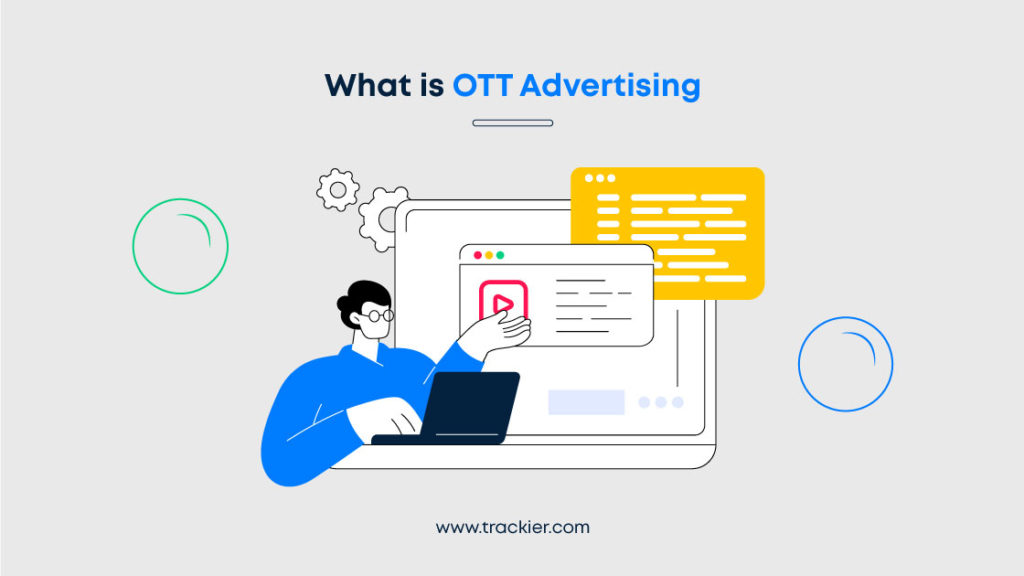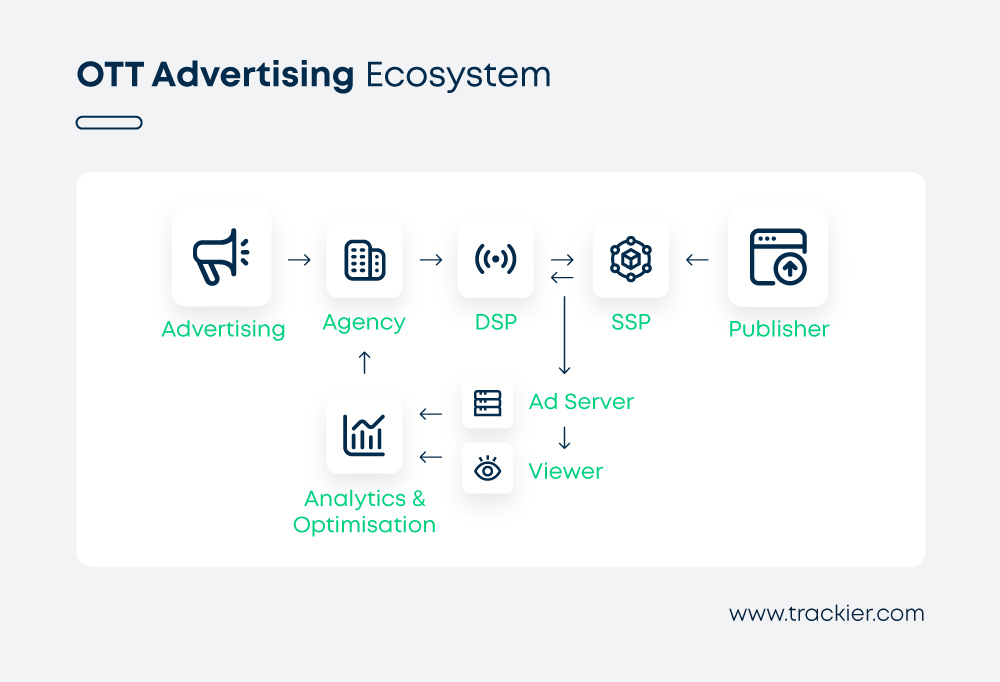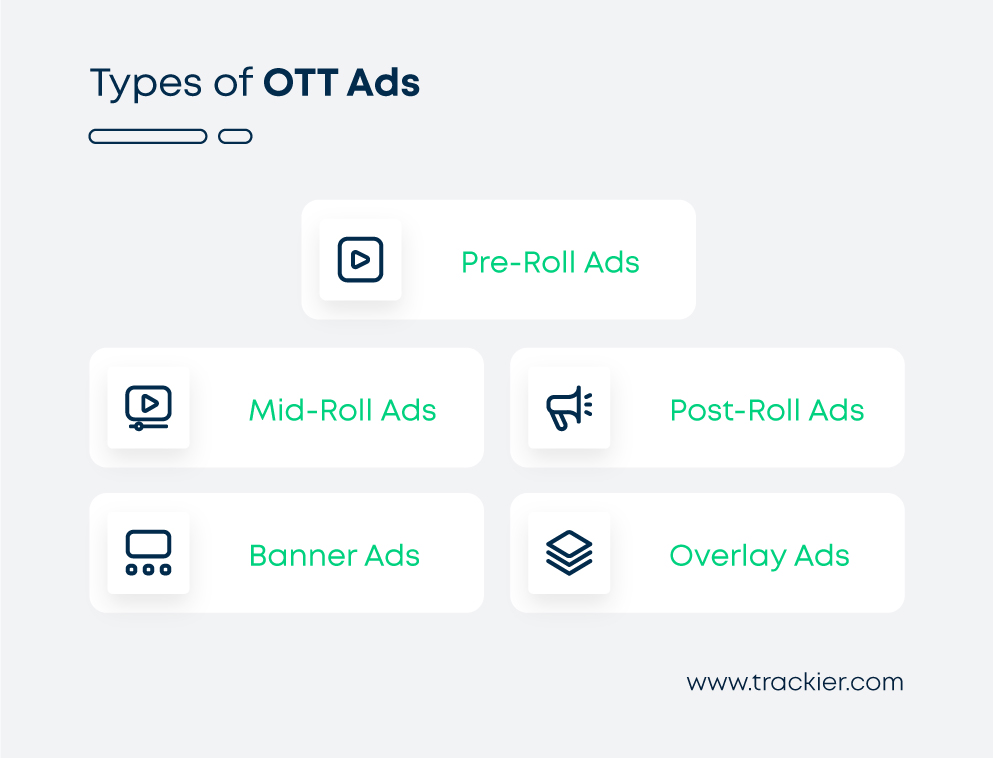Advertisements are everywhere. You move your head and your eyes will probably stumble upon an ad placement. Just like Search Engines, Websites, and YouTube, OTT platforms have also emerged as a beneficial way for advertisers to reach their target audience. Such is a massive rise of OTT advertising accelerated by Covid-19, that the industry itself is expected to reach $119 billion in revenue by the end of 2023. In this glossary listing, we’ll explore what is OTT advertising in detail along with its type, media buying models, process, and examples.

What is OTT Advertising
OTT advertising means reaching the audience through advertising on OTT platforms like Netflix, Hulu, Amazon Prime Video, etc. These types of streaming services are directly connected to consumers via the Internet without a traditional cable, broadcast, or satellite system.
Through OTT advertising, advertisers and brands can reach a specific audience segment who are watching the content on their internet-connected devices like smartphones, tablets, laptops, or smart TVs.
Most marketers use OTT and CTV interchangeably, but please note that these two are different terms, in terms of meaning as well as use case. Let’s break it down for you.
- OTT – OTT or Over-the-top streaming services like Netflix, Hulu, Prime Video, etc. to watch content on internet-connected devices including smartphones, tablets, and smart TVs.
- CTV – Connected TV or CTV are the devices you use to access streaming platforms. These include Smart TVs, Amazon Firestick, Google TV, Apple TV, Chromecast, Gaming Consoles, etc.
How Does OTT Advertising Work: Explained With an Example
To put it in a better context, let’s understand how OTT advertising works with an example. Let’s say you work in a marketing department of a popular fast-food chain and you want to promote a new burger variation ‘The Ultimate Burger’ via OTT advertising. Here’s how you can go about it.
- Setting the Target Audience: Set the target audience on the OTT advertising platform based on your ideal customer profile. You can choose specific demographics, interests, and even geographical locations to run your ads. In this case, you might want to reach people aged 18-34 who live in an urban area and enjoy fast food. You can also target your website visitors and past customers as well via site targeting.
- Asset Creation: You’ll create a short video ad highlighting the ‘what’s special in the ultimate burger’. The ad will be around 15-30 seconds with attention-grabbing headlines and a special launch offer to get the user’s attention.
- Placement: Based on your budget and requirements, you’ll choose a placement of your ad on the OTT platform.
- Ad Delivery: Your ad is delivered to viewers who fit your specified criteria while they’re watching content on the said OTT platform.
- Measurement: OTT advertising allows you to track engagement metrics such as views, click-through rates, and completion rates. You notice that a high percentage of viewers are watching your entire ad and clicking through to your website to learn more.
Types of OTT Ads
Types of OTT ads depend on the placement advertisers choose. They are as given below:
- Pre-roll ads: As the name suggests, these ad types are shown to viewers in the beginning of the content. They are usually 15-30 seconds long.
- Mid-roll ads: These ads appear in the middle of the content and they can be a bit longer than pre-roll ads. They are usually 30 seconds to 1 minute long.
- Post-roll ads: These ads appear when the content has ended. They can be up to several minutes longer.
- Banner ads: These are static ads that appear at the top or bottom of the screen during the content.
- Overlay ads: These ads appear on the top of the content without interrupting the viewing experience. They are clickable, often leading to a brand’s landing page.
How to Buy OTT Advertising
There are many ways to buy OTT advertising, including buying it directly from the OTT platforms or resellers, or purchasing them programmatically.
Streaming publishers and service providers offer ad contracts to advertisers and agencies who can choose when, where and to whom their ads will be displayed.
OTT resellers pre-purchase the ad space from the streaming publishers and sell them to advertisers. They also have access to the OTT ad inventory through auction-based ad exchanges.
There are two main currencies that are used to purchase OTT advertising, as given below:
- CPM (Cost per Mille): It is the measure of impressions served.
- CPCV (Cost per Completed View): In this model, advertisers are only charged when a user watches the complete video.
How Much Does OTT Advertising Cost
There is no one answer for all the OTT platforms to this question. The cost of running an OTT ad on a streaming platform varies from platform to platform. For example, for Hulu, this cost lies somewhere between $50-$75 CPM.
According to advertisers, the approximate cost of buying an ad space on Netflix is $39 – $45 CPM. Similarly, the cost of OTT advertising on Prime Video is between $25–$75 CPM.
Having said that, the cost of running an OTT ad depends on multiple factors including geography, duration, target audience, and placement.
Top Influencers of OTT Advertising Cost
- Geography
- Length of the ad campaign
- Target audience
Why Businesses Should Invest in OTT Advertising?
You’ll be surprised to know that around two-thirds of respondents in a survey said that they would choose an ad-supported subscription over an ad-free one. What does this mean for businesses like yours? Possibilities are unlimited.
However, the massive reach of OTT platforms is not the only reason why businesses should invest in OTT advertising. Some of many other reasons include:
- Targeting capabilities: OTT advertisements are targeted on the basis of data, therefore they provide 5-8x higher ROAS than less-focused advertisements. If you’ve been investing in TV advertisements, OTT advertisements are a better option since they are more targeted and data-driven.
- Better customer engagement: Let’s admit it we belong to a multitasking generation. We like to scroll through our smartphones while watching TV. Therefore, an OTT ad has a higher chance of being engaged as compared to traditional TV advertisements.
- Lesser wastage: OTT ads are less expensive than traditional TV and OOH ads. Using real-time data, advertisers can adjust their strategy accordingly to minimize ad spend wastage.
- Privacy-friendly: OTT ads don’t use cookies and only rely on first-party publisher data for targeting, making it a bullet-proof advertising option post the end of the third-party cookies era.
Bottomline
If you’re a brand whose target audience is somewhere between 18 and 50 that enjoys content on OTT platforms, OTT advertising is a cost-efficient and effective advertising channel. It is more affordable, hyper-targeted, and wastage-proof, making it a much more preferred advertising channel as compared to traditional TV.
However, OTT ads are still not for everyone. If you’re a small business with a tight budget or a brand that enjoys a good ROI on traditional and OOH channels, you might struggle to get results in OTT advertising.

